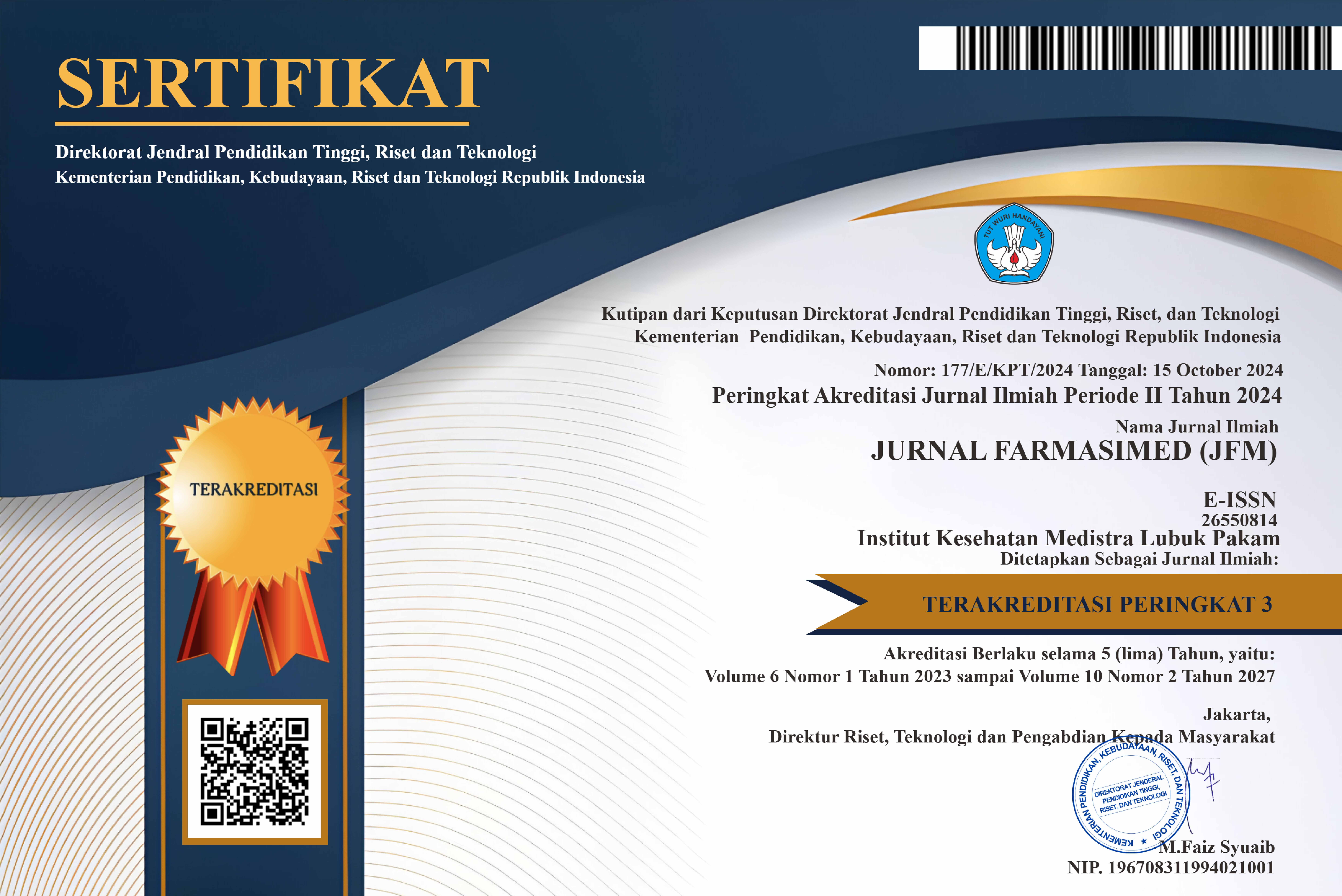Development of Molecularly Imprinted Polymer Materials as Selective Recognition Elements for Electrochemical Meropenem Sensors
DOI:
https://doi.org/10.35451/j884sv81Keywords:
molecularly imprinted polymer, meropenem, sensor , imprinting factor, selectivityAbstract
The rising prevalence of bacterial resistance to carbapenem antibiotics, particularly meropenem, highlights the urgent need for rapid, selective, and efficient detection methods. This study reports the synthesis of molecularly imprinted polymers (MIPs) based on methyl methacrylate (MMA) as selective recognition elements for electrochemical meropenem sensors. Bulk polymerization was employed using MMA as the functional monomer, ethylene glycol dimethacrylate (EGDMA) as the crosslinker, dimethyl sulfoxide (DMSO) as the porogen, and benzoyl peroxide (BPO) as the initiator. Both non-imprinted polymers (NIPs) and molecularly imprinted polymers (MIPs) were prepared, followed by template extraction through sequential washing with acetonitrile, methanol–acetic acid, and methanol–deionized water to generate specific recognition cavities. Characterization using Fourier Transform Infrared Spectroscopy (FTIR) and Scanning Electron Microscopy (SEM) confirmed the success of molecular imprinting, as evidenced by the disappearance of characteristic meropenem bands and the formation of porous cavities in the MIP. Adsorption studies revealed that the MIP exhibited a higher adsorption capacity (8.9940 mg/g) compared to the NIP (3.9904 mg/g), yielding an imprinting factor (IF) of 2.25. Selectivity testing against the competing analyte amoxicillin produced a selectivity coefficient (α) of 1.06, indicating preferential binding toward meropenem despite modest discrimination. These results demonstrate that MMA–EGDMA-based MIPs possess promising potential as selective recognition elements for electrochemical meropenem sensors. The developed material not only contributes to the advancement of functional polymer research but also offers practical opportunities for real-time monitoring of antibiotic levels in clinical and environmental samples.
Downloads
References
[1] Herlina, Muhammad Ali Zulfikar, Lasmaryna Sirumapea B Platinum and Cobalt hydroxide – modified Platinum Electrode as Sensor for Electrochemical Oxidation of Amoxicillin. 6:213–223
[2] Milla P, Ferrari F, Muntoni E, Sartori M, Ronco C, Arpicco S (2020) Validation of a simple and economic HPLC-UV method for the simultaneous determination of vancomycin, meropenem, piperacillin and tazobactam in plasma samples. J Chromatogr B Anal Technol Biomed Life Sci. https://doi.org/10.1016/j.jchromb.2020.122151
[3] Amri AM, Azis MY, Zulfikar MA (2024) Synthesis and Characterization of Magnetic Molecularly Imprinted Polymers Targeting Capsaicin. J Kim Val 10:173–180
[4] Steffens NA, Estevan S, Nichelle SM, Natália P (2021) Meropenem use and therapeutic drug monitoring in clinical practice : a literature review. 610–621
[5] Wang Q, Xue Q, Chen T, Li J, Liu Y, Shan X, Liu F, Jia J (2021) Recent advances in electrochemical sensors for antibiotics and their applications. Chinese Chem Lett 32:19–29
[6] Zhang Y, Zhao G, Han K, Sun D, Zhou N, Song Z, Liu H, Li J, Li G (2023) Applications of Molecular Imprinting Technology in the Study of Traditional Chinese Medicine. Molecules 28:1–25
[7] Haghdoust S, Arshad U, Mujahid A, Schranzhofer L, Lieberzeit PA (2021) Development of a MIP-Based QCM Sensor for Selective Detection of Penicillins in Aqueous Media.
[8] Golker K, Nicholls IA (2016) The effect of crosslinking density on molecularly imprinted polymer morphology and recognition. Eur Polym J 75:423–430
[9] Frigoli M, Krupa MP, Hooyberghs G, Diliën H, Eersels K, Grinsven B Van, Lowdon JW, Cleij TJ (2024) Electrochemical Sensors for Antibiotic Detection : A Focused Review with a Brief Overview of Commercial Technologies.
[10] Ma X, Wang Y, Wang W, Heinlein J, Pfefferle LD, Tian X (2023) Strategic preparation of porous magnetic molecularly imprinted polymers via a simple and green method for high-performance adsorption and removal of meropenem. Talanta 258:124419
[11] Sirumapea L, Zulfikar MA, Amran MB, Alni A (2021) Selective solid-phase extraction of meropenem from human blood plasma using a molecularly imprinted polymer. Indones J Chem 21:1167–1179
[12] Atta MY, Hegazy MA, Mahmoud AM, Ghoniem NS (2022) Electrochemical Sensor for Meropenem Therapeutic Monitoring in Human Plasma Based on Carbon Nanotubes Modified Basal Pyrolytic Graphite Electrode. J Electrochem Soc 169:097504
[13] Ramanavicius S, Samukaite-Bubniene U, Ratautaite V, Bechelany M, Ramanavicius A (2022) Electrochemical molecularly imprinted polymer based sensors for pharmaceutical and biomedical applications (review). J Pharm Biomed Anal. https://doi.org/10.1016/j.jpba.2022.114739
[14] Herlina, Zulfikar MA, Buchari (2021) Electron transfer in electro-oxidation of amoxicillin using platinum electrode and platinum modified cobalt electrodes. Key Eng Mater 874 KEM:155–164
[15] Mostafa IM, Meng C, Dong Z, Lou B, Xu G (2022) Potentiometric sensors for the determination of pharmaceutical drugs. Anal Sci 38:23–37
[16] Gao M, Gao Y, Chen G, Huang X, Xu X, Lv J, Wang J, Xu D, Liu G (2020) Recent Advances and Future Trends in the Detection of Contaminants by Molecularly Imprinted Polymers in Food Samples. Front Chem 8:1–20
[17] Yence M, Cetinkaya A, Çorman ME, Uzun L, Caglayan MG, Ozkan SA (2023) Fabrication of molecularly imprinted electrochemical sensors for sensitive codeine detection. Microchem J 193:109060
[18] López R, Khan S, Wong A, Sotomayor M del PT, Picasso G (2021) Development of a New Electrochemical Sensor Based on Mag-MIP Selective Toward Amoxicillin in Different Samples. Front Chem 9:1–9
[19] Handayani N, Setiadi Y, Sativa SO, Pinandita A, Serunting MA, Triadhi U, Nasir M, Zulfikar MA (2023) Tailored nanofibrous molecularly imprinted polymers for selective removal of di(2-ethylhexyl) phthalate: A computer-aided design and synthesis approach. J Water Process Eng 55:104112
[20] Adeleke VT, Ebenezer O, Lasich M, Mugo SM (2024) Theoretical insights into the compatibility of template-monomer-crosslinker-solvent for cortisol molecularly imprinted polymer pre-polymerization. Mol Syst Des Eng 9:99–111
[21] Lasmaryna Sirumapea, M Ali Zulfikar, M Bachri Amran and AA Synthesis and characterization of meropenem imprinted polymer Synthesis and characterization of meropenem imprinted polymer. https://doi.org/10.1088/1742-6596/1282/1/012063
[22] Bow Y, Sutriyono E, Nasir S, Iskandar I (2017) Molecularly Imprinted Polymers ( MIP ) Based Electrochemical Sensors for Detection of Endosulfan Pesticide. 7:662–668
[23] Sirumapea L, Zulfikar MA, Amran MB, Alni A (2018) An Optimization of Functional Monomer, A Preliminary Study of Meropenem Imprinted Polymer as Selective Sorbent. JKPK (Jurnal Kim dan Pendidik Kim 3:103
[24] Hasanah AN, Safitri N, Zulfa A, Neli N, Rahayu D (2021) Factors affecting preparation of molecularly imprinted polymer and methods on finding template-monomer interaction as the key of selective properties of the materials. Molecules. https://doi.org/10.3390/molecules26185612
[25] Putri T, Ali Zulfikar M, Wahyuningrum D, Syahjoko Saputra I (2022) Synthesis and Characterization of Molecularly Imprinted Polymers (MIPs) Using Humic Acid. J Pure Appl Chem Res 11:175–181
[26] Hasaneen N, Akhtarian S, Pulicharla R, Brar SK, Rezai P (2024) Surface molecularly imprinted polymer-based sensors for antibiotic detection. TrAC Trends Anal Chem 170:117389
[27] Surya SG, Khatoon S, Lahcen AA, Nguyen ATH, Dzantiev BB, Tarannum N, Salama KN (2020) A chitosan gold nanoparticles molecularly imprinted polymer based ciprofloxacin sensor. RSC Adv 10:12823–12832
[28] Bow Y, Syakdani A, Purnamasari I (2023) Performance Test of the Molecularly Imprinted Polymer ( MIP ) Endosulfan Sensor Potentiometrically. 3:46–51
[29] Majdi M, Mizani F, Mohammad-Khah A (2022) Quantitative Monitoring of Cefotaxim Ions by a New Potentiometric Sensor Based on Molecularly Imprinted Polymer. Anal Bioanal Electrochem 14:100–115
Downloads
Published
Issue
Section
License
Copyright (c) 2025 Herlina Herlina

This work is licensed under a Creative Commons Attribution-NoDerivatives 4.0 International License.
Copyright in each article is the property of the Author.

























